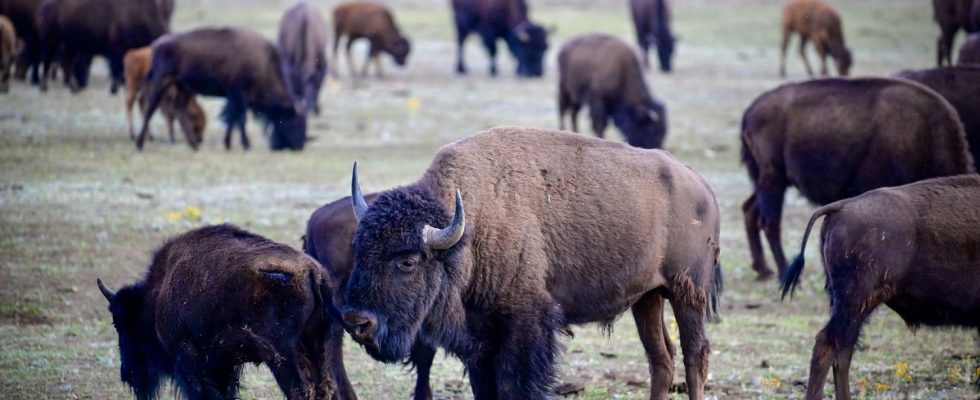In four months, 1,150 wild bison were slaughtered in Montana. If Native Americans and farmers claim a cultural and health practice, animal defenders denounce a “genocide”.
This story is set in the snowy plateaus of Montana, near Yellowstone Park, in the American Northwest, where the winter was particularly icy. This year, as has happened in the past, many herds of wild bison left the reserve in search of food and warmer temperatures.
>> United States: after 53 years in a Florida water park, the orca Lolita will return to its native Pacific Ocean
But like every year, hunters from Native American tribes were waiting for them at the exit. In four months, they shot 1,150 animals.
This is not a recreational hunt: if the tribes are authorized to kill these massive, immense bovids, recognizable by their hump and their brown coat, it is because they are suspected of carrying an infectious disease, brucellosis, which can contaminate domestic cattle – and cause cows to abort if they get too close to farms.
Under the “buffalo management plan” put in place 23 years ago to “protect the economic interest of Montana’s ranching”, eight tribes are therefore authorized to hunt them as soon as they leave the reservation: THE Pierced nose, Blackfeet, Confederate Tribes of the Umatilla Reservation, Northern Arapaho, Confederate Salish and Kootenai Tribes, crow And Shoshone Bannock Tribes.
1,150 bison killed, a record since 2005
Every year, the practice makes people cringe a little, but this year, nearly 1,200 bison were killed in a single season, a record since the winter of 2005. If we add the animals sent to the slaughterhouse or quarantined – the time to check if they are free from disease – we arrive at more than 1,530 animals taken out of the herds, according to the count of the New York Times (article in English).
“We had three years of very light migrationjustifies Cam Sholly, the manager of the park, in an interview with the American daily. This is one of the first major migrations out of the park in a long time.” But that’s too much for a population of about 6,000 in Yellowstone. We are getting dangerously close to the threshold of 3,500 animals, below which the maintenance of the herd is no longer assured.
As the hunting season draws to a close, non-governmental organizations (NGOs) campaigning for the vaccination of animals against brucellosis rather than their slaughter, denounce an excessive, “organized” massacre. “This is the worst animal genocide since the 19th century.”denounces Bonnie Lynn, a resident of the reserve at the head of YellowstoneVoice.
Roam Free Nation has meanwhile paid for billboards in four by three to denounce the method. “When there are 30 hunters from 10 different tribes jostling at the gatethey say, the hunt turns into a competition to see who will get their bison“, says its founder, Jaedin Medicine Elk, himself a member of a Cheyenne tribe.
All is good in bison
The tribes do not want to give up their ritual. They defend a cultural, even spiritual, practice that allows them to reconnect with their ancestors. Among the Amerindians, everything was good in the bison: its flesh for food, its fur for clothing, its skin for tepees, its bones for tools.
It was a symbol of abundance. Today, in fact, it’s mostly pâté and sausage. But this totem, which almost disappeared at the end of the 19th century (they were massacred in large numbers to subjugate the natives who lived in interdependence with them), has become inseparable from the history of the United States.
The Federal State therefore wants to spare everyone. Both to preserve hunting, while guaranteeing the survival of the species. Secretary of the Interior, Democrat Deb Haaland, who is herself the first Native American to serve in a presidential cabinet, acknowledges that bison “are inextricably linked to indigenous culture, prairie ecology, and U.S. historyShe recently announced $25 million to help conserve and restore herds across the American West.
